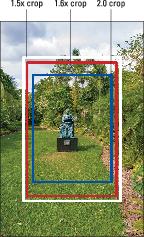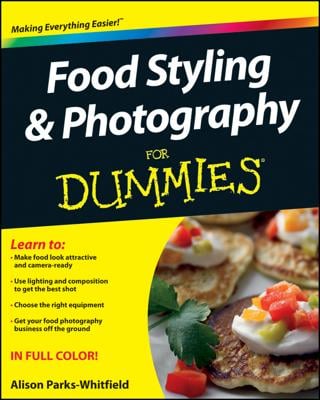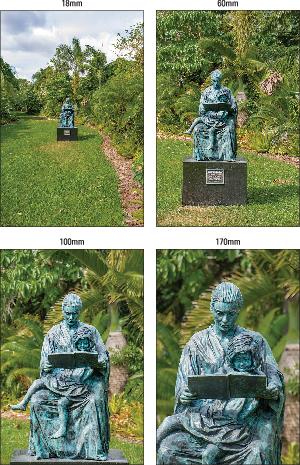Now that you know the technical definition of focal length — which, by the way, isn't really important to remember unless you want to impress a roomful of optical engineers — here is an explanation of focal length in real-world photographic terms:
- Focal length determines the angle of view. The shorter the focal length, the more subject area fits in the frame. Increasing focal length narrows the angle of view and makes your subject appear closer and larger. This image illustrates this fact, showing the same scene captured at four focal lengths. (A lower number indicates a shorter focal length.
Some focal length recommendations:
-
Landscape photography: Look for a wide-angle lens, characterized by a focal length of 35mm or shorter.
-
Nature and sports photography: Assuming that you'll be shooting at a fair distance from your subject, you need a telephoto lens, which has a focal length of 70mm or longer.
-
Portrait photography: Aim for a focal length in the range of 70-135mm. At other focal lengths, facial features can be distorted. A wide-angle lens, for example, can make your subjects appear sort of like how they look when you view them through a security peephole in a door. And a very long lens can flatten and widen a face.
-
-
The angle of view produced by any focal length depends on the size of the image sensor. You get the stated focal length only on a camera that has a full-frame sensor — that is, one that's the same size as a 35mm film negative. With smaller sensors, the angle of view is reduced because the sensor is no longer large enough to capture the entire area that the lens can see. The resulting picture is what you would get if you took a picture with a full-frame camera and then cropped the picture. The measurement of how much frame area you lose is known as the crop factor.
On a digital camera, the angle of view that can be recorded at any focal length depends on the camera's crop factor.
Because sensor sizes vary, the crop factor depends on the camera model. Most dSLR and mirrorless image sensors have a crop factor ranging from 1.5 to 2. This image illustrates the image area at these crop factors when compared to the full-frame view.
To figure out what angle of view a lens will provide, just multiply the camera’s crop factor (which should be stated in the camera specs) by the lens focal length. For example, if the camera has a crop factor of 1.5, a 50mm lens gives you the same angle of view as a 75mm lens on a full-frame digital or 35mm-film camera.
-
Focal length affects depth of field. As focal length goes up, depth of field — the distance over which focus appears sharp — goes down.
What about the crop factor and depth of field? They're unrelated; you get the same depth of field from a particular focal length no matter what the size of the sensor. The image produced by a camera with a smaller sensor may appear to have a different depth of field than one from a camera with a full-frame sensor, but that's only because you're looking at different portions of the scene.
A prime lens offers a single focal length; a zoom lens, a range of focal lengths. For example, a lens might zoom from 18 to 55mm.
In camera or lens advertisements, the zoom range is sometimes described in terms of an “x” factor, as in a 3x zoom. Here, the x means times, with the value indicating the difference between the shortest and longest focal length of the lens. So an 18–55mm lens boasts a 3x zoom, for example (18 x 3 = 54).
As a general rule, prime lenses equate to better-quality photos because a lens can be engineered to optimal performance at only a single focal length. That said, one of the best lenses is the super zoom; it has a monster focal length range — 18 to 270mm. Newer lenses perform better in this regard than those manufactured in the past.
- Don't bother with digital zoom. For fixed-lens cameras, note whether the lens offers an optical or digital zoom. Optical zoom is a true zoom lens and produces the best picture quality. Digital zoom is a software feature that crops away the outside of the image and enlarges the remaining area, a process that lowers image quality.
As for cellphone cameras, finding the focal length usually requires inspecting the image metadata (hidden data stored with the digital photo file). You may be able to view this data in a photo program. Just know that cellphone cameras typically have wide-angle lenses.


